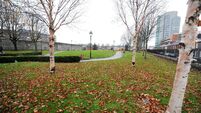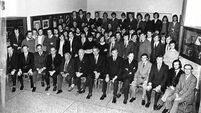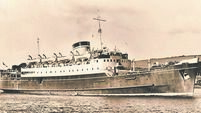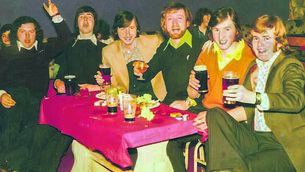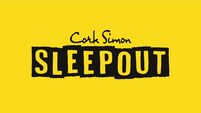Remembering Guy’s office in Cork city, and afternoon tea parties of the past
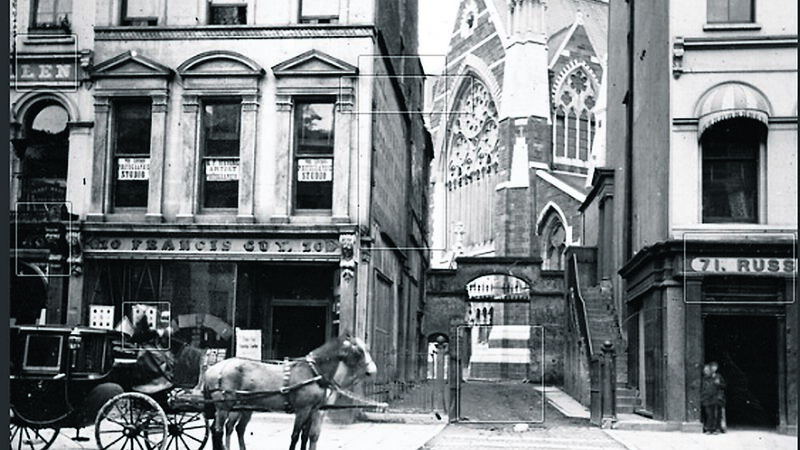
Guy’s on Patrick Street around 1867
WE still don’t have any firm answers on the identity of that wonderful old lady, Kate Davis, who featured in Throwback Thursday last week, from a photo supplied by Fintan Bloss - but Mr Bloss himself has found what is perhaps a clue.
“I was just checking the 1901 census again,” writes Fintan, “and discovered a Kate Davis at 1, Popes Quay. She was a 40-year-old from Tipperary, living there with her husband, John, aged 47, and their children.
“Also living there was a James O’Shea, who was listed as being brother-in-law to the head of the household, so possibly Kate’s brother.”
As the North Mall is so near to Popes Quay, Fintan thought at first that this must be her, but on further consideration he felt that someone aged just 40 in 1901 would have been far too young to have sat for that picture taken at least 20 if not 40 years earlier (on a glass plate, if we’re not mistaken).
And we felt the same. Perhaps she was the mother of John Davis? And perhaps she had died before the 1901 census?
“Maybe we will never know,” says Fintan, “unless some Throwback Thursday reader can come up with anything! We will have to wait and see.”
Now that is a challenge which surely someone will pick up. Anyone with a keen interest in family history, let’s hear from you! This chapter is not closed yet.
On the topic of street photographers and all those wonderful family pictures that readers shared with us over the past couple of weeks, here is one very important fact that is noticeable when you look closely.
In every single one, the person or group snapped was on the move, walking, not standing posed. That means that the photographer must have been a quick man on his feet (we dare to say ‘man’ because it almost certainly was), and would be constantly watching the crowds passing by, spotting likely groups that would not be averse to having their picture taken, and then leaping out to grab the image before they knew it.
Proud grandparents with their grandchildren would have been excellent choices, since they would almost certainly go in afterwards to buy the pictures and show them off to friends, carefully sticking them into an album afterwards (which is why so many survive today).
Similarly, the photographers may have targeted young mothers with a pretty little son or daughter all dressed up for the day out in the city. Or a young couple strolling hand in hand. All would get snapped, immortalised on one day in their life, and given a little card with the individual number on it to identify their specific picture later on.
What did that photographer do once he had his quota of shots? He would almost certainly have gone back to the studio and developed the film, probably making up a contact sheet of all the pictures taken that day, rather than developing each one, which might risk a loss if the person involved did not choose to come in to pay and collect.
One of the major companies of old Cork where the street photographer could have rented his studio would have been Guy’s, that legendary stationers and publishers of the annual directories, with their huge premises on Patrick Street.
A wonderful old photograph of the building in the 1860s still exists, showing a stately carriage stopped outside, presumably while the occupants were in the shop, being attended to by bowing assistants as they chose writing paper or pens.

Guy’s also supplied photographic materials and indeed had its own studios, so it would have been a good place to make your base as an operator who made the street his business.
That picture, from around 1867, provides fascinating detail on the archway entrance to Saints Peter & Paul’s church, the guarding iron pillars which suggest a gate, and the steps up the side of Russell’s store. All now vanished as if they had never been.
They do suggest though that the church had its own important grounds and entrance, whereas today only a tiny strip of green to the rear, on Paul Street, hints at its former extent.
It is a great idea to look at every street corner, every name plaque, every twist and turn of this beloved city, and ferret out what and why and where.
The archways on South Mall, which once received goods from the river outside to the ground floor of properties, are a well-known example, but there are so many others. Where did that laneway lead? Where can you see the river that once ran under Patrick Street? Why are those steps there? Why does that street bend so sharply for no reason? It’s a never-ending fascination and hobby.
Olivia Coogan was musing on the approach of Mother’s Day (on March 19 this year), and considering what it has become, as compared to her own memories of childhood.
“Hotels and restaurants undoubtedly will be packed with mothers and daughters bonding over lunches and afternoon tea,” said Olivia.
“Ladies wearing Instagram faces being ever so polite as silver teapots are brought to tables groaning with minute sandwiches, scones and cake.
“Mobile phones will be beeping and clicking, photographs being taken over and over until the right pose has been secured.”
Olivia had just such an experience herself not long ago, sitting in an expensive five-star hotel with her daughter whilst a display of many brands of teas swirled before her eyes.
“To say I was confused is an understatement. My eyes glazed over. I eventually inhaled a deep breath in an attempt to combobulate myself. Meekly, I replied that Barry’s Gold Blend was what I was used to, then tried to offset my embarrassment by saying, ‘Sure I’m from Cork, what else would I be drinking?’
“My remark fell on deaf ears. Of course, I couldn’t just accept that so I went off on a ramble about Peter Barry and Barry’s tea. The waitress looked at my daughter; she in turn looked at me.
“Not one to give in, I gave a performance worthy of the Everyman Theatre telling the story of Barry’s tea but nobody clapped...
“The last of the evening sun beat through the glass, making me squint. I felt like a bee trapped against the pane. My daughter was talking animatedly to me but I strained to hear what she was saying as she was competing against the background music, which didn’t belong to any particular genre, so no mood was created in the over-imposing dining room.
“We ate copious amount of sugar but we were still hungry. Reproductions of women with scowling faces looked down from the walls at us as if we were imposters in this charade.”
This vivid recent experience brought Olivia back many years to a very different time and ethos.
“I remembered a time in the early 1960s when I used to accompany my mother to Afternoon Tea in Mrs Cummins’ back garden.
“Nellie Kidney (as she was affectionately known) lived on Rope Walk in Blackrock village. She held these afternoon teas to raise funds for her brother, Fr. Kidney, who was out in the Missions.” (For years, reveals Olivia, she thought ‘the Missions’ was an actual country.)
She continues: “I had four siblings and we all took turns in accompanying our mother. A tea party, after all, was a real cause for celebration, and brought colour to drab lives.
“Fishermens wives, creased with worry, together with other neighbours, would come from nearby Convent Road, Cat Lane, Mahon Terrace and Dunlocha Cottages. Occasionally, a few from the village of Ballinure would make it down.
“It always seemed to be summertime when these tea parties took place and there must have been divine intervention because I never remember even a hint of rain.

“Madge, my mother, forever the fashion icon, loved the opportunity to dress up for these occasions. I remember once she wore a fitted pink coat dress with buttons all down the front, and high heels. I was so proud that she was my mother; I held her hand tightly in case her attention would be claimed by somebody more worthy than me!
“I would have changed into a smart summer dress, made by our neighbour Katy next door. My plaits swinging down my back, my feet marching purposefully. The expectation of the afternoon made our hearts beat a little quicker and our flushed faces were reflected in the scarlet poppies swaying in the breeze.
"Daisies and buttercups were out in abundance. The scent of roses mixed with the aroma of tea wafted around the long wooden tables laid out in strict precision.
“Nellie Kidney was small of stature but was no shrinking violet, she was the Maître d and you knew it. In her hands she held a ginormous stainless steel teapot, like a warrior about to do battle.
“The tables were dressed with tablecloths and were bursting with colour. Queen cakes with cerise pink, white, or chocolate icing together with butterfly cakes bursting with cream and jam were brought out by her family old enough to carry a tray. The helpers were like soldier ants going in and out of the kitchen.
“There was no state of frenzy; everybody was given their cakes promptly and the tea was poured. I cannot remember if sandwiches were a feature or not, but it didn’t matter. The ingredients of the feast were around the table.
“The flavour of the day was women and children chatting among themselves. The background was birdsong, humming of bees, and laughter. There was an occasional raised voice if a child pushed the boundaries, but mostly we were well behaved.
“Sometimes, voices were dropped as secrets and gossip was exchanged. Everybody was animated with the simple pleasure of it all. As I said, the sun always seemed to make an appearance, or at least that it how I remember it. When it was over we felt reborn and full.”
Soon, now, observes Olivia wryly, the Echo and the Examiner will be full of advertisements from hotels and restaurants trying to lure us to their fine establishments for Mother’s Day.
“What I wouldn’t give to sit in the garden on Rope Walk once more, and inhale the sweetness of the tea poured from the big shining stainless steel teapot.
“No cameras or pouty posing faces, just people being people.
“Cheers to you, Mrs Cummins, the inventor, for me at least, of Afternoon Tea!”
What a great memory and such a vivid picture of a long-ago summer ritual, Olivia. Thank-you so much for sending it in.
If anyone else has similar memories, then let us see them! Email jokerrigan1@gmail.com. Or leave a comment on our Facebook page: https://www.facebook.com/echolivecork.
